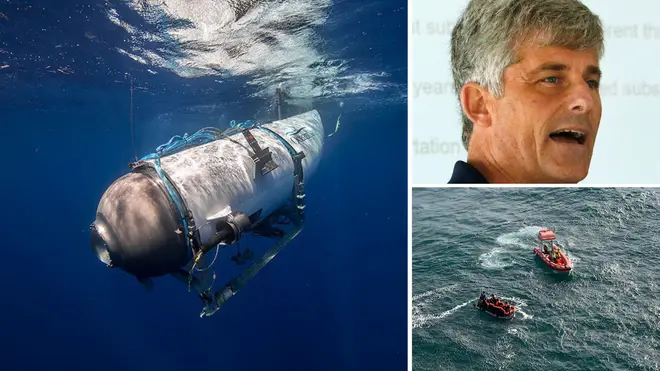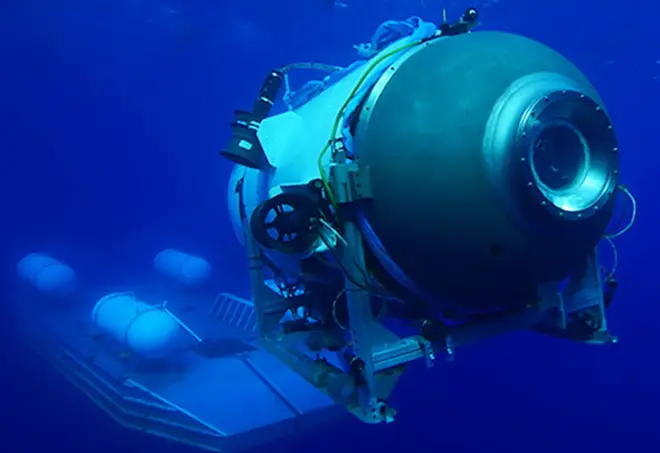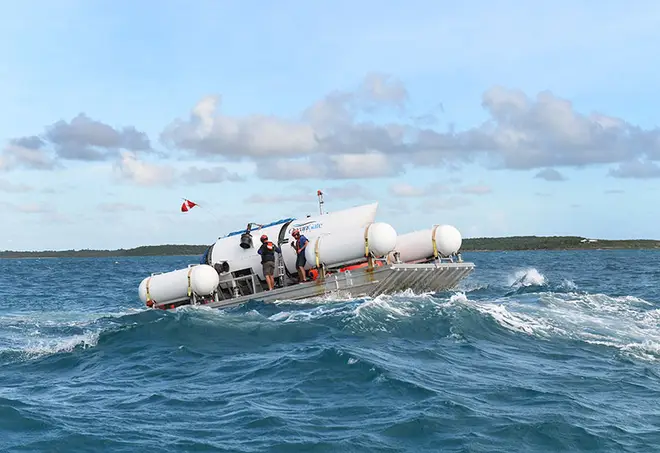
Matthew Wright 7am - 10am
23 June 2023, 08:25 | Updated: 23 June 2023, 11:44

NASA, Boeing and the University of Washington have all distanced themselves from the Titan sub that suffered a "catastrophic implosion" while descending to the Titanic wreck, killing all five passengers onboard.
OceanGate, the company that manufactured the doomed vessel, parts of which were recovered from deep in the Atlantic on Thursday night, had said that its engineers worked with the US space agency and used its logo in promotional materials.
The company also said in interviews and on its website that it worked with aircraft manufacturer Boeing and the University of Washington to design the "pressure vessel" - a key safety feature that appears likely to have failed.
NASA said it had provided some remote consultation on the project, but did not give any approvals for the build. Boeing and the university denied any involvement at all in the Titan. Both helped on initial designs for a much less capable predecessor to the Titan, Cyclops 1.
OceanGate has come under fire since news of the missing ship broke. Stockton Rush, the OceanGate CEO who died onboard, previously admitted he had "broken some rules" while building the Titan.
Read more: US Navy ‘knew about Titanic sub implosion days ago’ from secret underwater microphones

The company said in February 2020 that it partnered with NASA and the agency's Marshall space flight centre in Alabama would "serve as the facility where the development and manufacturing of a new aerospace-grade hull is completed". The pandemic scuppered this plan.
NASA said: "For the safety of our team members during the COVID-19 pandemic, as well as limited resources and availability, NASA Marshall engineers only participated remotely in technical interchange meetings with OceanGate, providing consultation for materials and manufacturing processes based on industry standards.
"We did not provide any approvals for the project as OceanGate was the technical authority."
Boeing said it was "not a partner on the Titan and did not design or build it". The University of Washington also denied involvement in making the ship.

Michael Guillén on his experience of diving to see the Titanic
But in an interview last year, Mr Rush said that OceanGate had worked with all three institutions to develop the pressure vessel for the Titan.
Mr Rush said: "There are certain things that you want to be buttoned down."
"The pressure vessel is not MacGyver at all, because that's where we worked with Boeing and NASA and the University of Washington.
"Everything else can fail, your thrusters can go, your lights can go. You're still going to be safe."
Mr Rush admitted in an earlier conversation that he had broken rules with the materials used to build the Titan's hull. A clip emerged where Mr Rush told Mexican actor Alan Estrada about the sub’s seven-inch thick acrylic window - the only way to gaze out onto the wreck of the Titanic.

He said the window gets "squeezed" as the craft gets down to 12,500 feet below the surface.
"If it is going to fail, the structure gives a ‘warning,’ he says in the video. But Rush admits in the clip he had “broken some rules to make this." Asked what the window is made from, he says: “It’s acrylic - plexiglass.
"It is seven inches thick and weighs about 80lbs. When we go to the Titanic it will squeeze in about three-quarters of an inch and just deforms.Acrylic is great because before it cracks or fails it starts to crackle so you get a huge warning if it’s about to fail."
Mr Rush adds in the video: "I’ve broken some rules to make this.“I think I broke them with logic and good engineering behind me. The carbon and firmer and titanium, there’s a rule you don’t do that - well I did.
"There’s picking the rules that you break that are the rules that will add value to others and add value to society, and that really to me is about innovation."

It comes as it emerged that the US Navy detected the Titan's implosion days before the ship was found.
The implosion was recorded by a secret acoustic monitoring system designed to detect submarines, The Wall Street Journal reported.
A senior US Navy official told the newspaper: “The US Navy conducted an analysis of acoustic data and detected an anomaly consistent with an implosion or explosion in the general vicinity of where the Titan submersible was operating when communications were lost.
“While not definitive, this information was immediately shared with the Incident Commander to assist with the ongoing search and rescue mission.”

Submersible lost on dive to Titanic suffered 'catastrophic implosion' – US Coast Guard
Following the submersible's disappearance on Sunday, the US Navy reviewed its acoustic data and discovered an anomaly aligned with an implosion or explosion, according to a senior Navy official who spoke to the Associated Press.
This anomaly was found in the general vicinity of where the Titan submersible was operating when communication was lost.
The Navy relayed this information to the Coast Guard, which continued its search efforts.
Steffan Watkins, an aircraft and naval research consultant, told The Telegraph the US Navy had spent a huge sum on building a new, deep-sea sensor network in the past five years “that they don’t talk about”.
He said: “They’re deploying underwater detection tech that’s supposed to detect the most advanced, quietest subs, so I’d expect narco ‘subs’ and sketchy submersibles that implode must be child’s play for them.”
Read more: James Cameron 'struck by similarity' between Titan sub tragedy and sinking of the Titanic in 1912

Marr Monologue 22/06
Mark Cancian, a senior adviser at the Center for Strategic and International Studies, remarked that he would have been surprised if the US military's sensors had not detected the implosion.
He explained that although they suspected what had occurred, they couldn't be entirely certain due to the nature of the data—lines on a graph.
Cancian explained that simply relying on graph patterns to justify not conducting a search would not be acceptable to many.
“And if you try to convince people you weren’t doing a search because the lines on a graph indicated an implosion, that wouldn’t be acceptable to many.”
On Thursday, the US Coast Guard announced the discovery of wreckage from the submersible in close proximity to the remains of the Titanic, which rests 12,400 feet beneath the ocean's surface.
The four-day search-and-rescue operation concluded with officials finding debris on the sea floor that was consistent with the implosion of the submersible's pressure chamber. OceanGate declared the five passengers as presumed dead.
US Coast Guard Rear Admiral John Mauger noted that it was too early to determine if the implosion occurred at the time of the submersible's last communication on Sunday.
Additionally, the sonar buoys used by the search teams that arrived later did not detect the implosion.
The Coast Guard will continue searching near the Titanic for further clues regarding the incident involving the Titan.
Efforts to recover the submersible and the remains of the five deceased individuals will also persist.